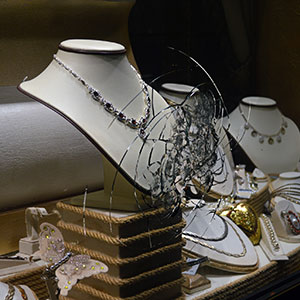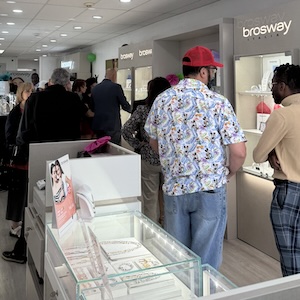
While jewelry crime has dropped, the industry remains dangerous, and jewelers still remain vulnerable to smash-and-grabs and grabs-and-runs, said Scott Guginsky, vice president of the Jewelers’ Security Alliance, at an April 16 seminar on crime prevention at the American Gem Society Conclave in Austin, Texas.
These two types of crimes are now happening at malls in particular, he said.
“You would think you’re safe in a mall,” he said. “Right now, malls are dangerous for smash-and-grabs and grab-and-runs. [Criminals] like those locations, because there’s a lot of places they can run.”
Guginsky, a retired New York City police detective, gave attendees the following tips to keep your store safe:
• Make sure your showcases have burglar-resistant laminated glass on the front and sides.
“We have seen, when a sledgehammer hits a case, and all four sides just buckle,” he said. “You want to make sure you have proper glass. It slows [the thieves] down; they can’t move as much. When the glass is good, they put their hands in. They cut themselves. Leaving blood on a crime scene is like leaving a driver’s license on the crime scene. Sooner or later, they’ll be charged with that crime, using DNA.”
Another thing to consider: installing an alarm that sounds when the glass breaks or there’s strong motion.
“When that alarm goes off, [the thieves] are going to run,” he said.
• Disperse your more expensive items throughout your store.
“Back in the day, when I worked jewelry crimes in New York City, we knew that you could go to the back of the jewelry store, and to the left, there was bridal,” Guginsky said. “If you’re a watch dealer, you don’t want to leave your nice watches by the front door. Make it more difficult. Spread the value out. Now [robbers] have to pick and choose what they’re going to do. So they just can’t go from one showcase to the next.”
• If you have a door buzzer, use it.
“You control your environment,” he said. “No one has an absolute right to come into your store. If someone’s masked up with a hood and plastic gloves, you’re not going to let them in. If you use a buzzer, you’re going to stop a lot of stuff.”
• Hire an off-duty police officer or retired detective as security.
“People who have been doing this for years see things you don’t see,” said Guginsky. “Police officers have a sense that nobody else has.”
• For grab-and-runs, possible red flags include someone talking on the phone during the presentation, a person wearing heavy clothes when it’s hot outside, a customer that asks to see the most expensive item in the store, and when a person seems to be making contact with someone outside.
One way to stop a possible thief is to offer them a glass of water, because then you have their fingerprints.
• Keep a log of suspicious activities.
“Keep a book, and say, ‘a male came in, a group came in, a car came around with no plates on it,’ and write down the day,” Guginsky said. “If, three weeks from now, God forbid something happens, you have a logbook about what happens on that day.
He also said staff should have a code word that they can say out loud when they notice something suspicious, such as looks like rain or what’s for dinner.
In addition, when jewelers notice something suspicious, they should call both JSA and their local police department.
“You have to let the police know what’s going on,” he said. “Once it’s documented, it becomes the problem of the commanding officer of the precinct.”
• It also helps to forge a relationship with the local police department.
“You should know the local police officers where you live,” Guginsky said. “They may even give you their cellphone. So you can say, ‘We just had a guy in here. We feel uncomfortable.’ Then they’ll swing by, increase patrols at your store.”
• Install surveillance cameras that take eye-level pictures.
“Facial recognition works,” Guginsky said. “But you need a good picture. You want eye-level cameras inside the store, outside the store, including cars in the parking lot. That’s excellent evidence for the police. Ceiling cameras often just get just the tops of people’s heads or hats, which is useless.”
• Use tracking devices, like Apple AirTags, in jewelry boxes and watches. They are becoming increasingly important in solving cases, Guginsky said.
• Do not resist. This always been one of JSA’s strongest suggestions, and it’s particularly important when you’re discussing smash-and-grabs, where the perpetrators might be armed.
“The robbers might have guns or knives,” Guginsky said. “Never resist. You will get hit with a sledgehammer.
“Jewel thieves aren’t looking to assassinate people, they want to steal jewelry,” he added. “We do not like to see jewelers pull guns and go after bad people, because that’s when there’s going to be shots fired, and people are going to get killed or hurt.”
• If you do have an incident, contact JSA.
“Our crime analysts call each detective,” he said. “We say there’s a robbery in this jurisdiction, this jurisdiction, and this jurisdiction. And what we do is, we connect the dots. We put all the detectives on an email chain. So the next case that happens, they’re in touch with the other detectives.”
In addition, if a diamond is stolen, contact GIA to report it as stolen,
“As long as you have a police report, GIA will flag the diamond as stolen,” Guginsky said. “Diamonds are very unique. There’s no two diamonds in the world that are alike. Just never keep your diamonds and the original certs together in the safes. It’s like a title to a car. Keep it separate.”
Photo: Getty Images
Follow JCK on Instagram: @jckmagazineFollow JCK on Twitter: @jckmagazine
Follow JCK on Facebook: @jckmagazine





